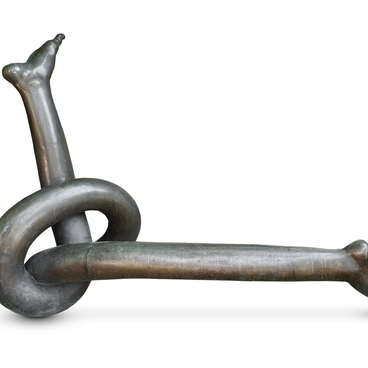This group sculpture depicts the moment of the abduction of Proserpine by Pluto. Pluto is shown in motion, carrying Proserpine on his shoulder. Both figures are naked and partially covered by cloth. At his feet is Cerberus, also known as Kerberos. The sculpture does not have a pedestal.
The marble composition titled “Kidnapping Proserpine” was created by the Italian sculptor Paolo Triscornia and is quite an unusual “guest”, being surrounded by modern statues at the Burganov House. The museum space is unique: there seems to be no concept of time, and the statues divided by centuries appear to be conversing silently. This conversation about the art of park sculpture began in Russia in the 18th century when parks in St. Petersburg and Moscow were embellished with numerous white marble compositions made by Italian artists. During that time, this extraordinary group sculpture was created in Moscow. It adorned the park ensemble at the estate in Kuntsevo, owned by a Russian merchant named Kozma Terentyevich Soldatyonkov.
The abduction of Proserpine — a story from Ovid’s “Metamorphoses” — was a popular subject matter in European Baroque art. A sculpture group of Pluto and Proserpine by the Italian artist Lorenzo Bernini is on display in the Borghese Gallery in Rome, and another composition by the French sculptor François Girardon can be found in Versailles.
A similar composition, inspired by the Italian classics, was created by the Russian artist Vasily Demut-Malinovsky for the building of the St. Petersburg Mining Institute in 1811. The constellation of masterpieces later welcomed the work “Kidnapping Proserpine” by the Italian sculptor Paolo Andrea Triscornia, which can be seen at the Burganov House.
The sculpture is characterized by power, dynamics, tension, and sensuality. The viewer can grasp the passion in Pluto’s gestures and marvel at the skillful naturalistic depiction of Proserpine’s body. The composition is very dimensional: each angle offers a new perspective, changes silhouettes, and places a different emphasis on such details as expressional folds, flying hair, and strong arms.
Unfortunately, time has not been kind to this work. When it entered the Burganov House, the sculpture had already lost many fragments, but even so, it remains an outstanding example of Italian sculpture from the turn of the 19th century.
This classical masterpiece does not stand out in the museum dedicated to modern
sculpture. Instead, according to Alexander Nikolayevich Burganov, “the
uniqueness of this museum lies in the conversation between statues.”


